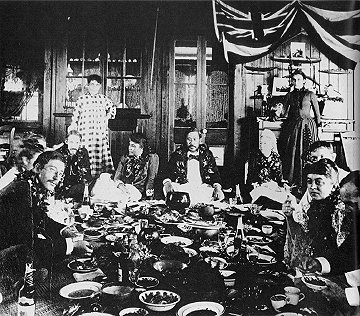KALUA PIG RECIPE
(Recipe submitted to the Blackhawk Museum Guild for their recipe book, August 2001, by my dad, who is their Webmaster and Consultant.)
Kalua (baked) Pig, Imu Pua‘a (earth-oven pig)
Go out and catch a medium-sized pig (pua‘a in Hawaiian), unless you
- expect more than one guest over 300 pounds,
- if the total weight of your guests is more than 1,500 lbs., or
- if you weigh more than 375 lbs. yourself,
in which case you should catch a larger pig. Prepare the pig for cooking … the same way you ordinarily do.
Dig a hole in the ground for an earth-oven (imu) approximately 6 ft. by 10 ft. and 3- to 4-ft. deep. It’s a good idea to do this at a location at least 4 ft. above sea level (be sure to check the tides) so that the pit doesn’t fill up with water and become a 6' x 10' wading pool or pig wallow instead. Keep the excavated dirt close by the pit so that it can be used as a cover later on.
Prepare a fire in the pit from kiawe (key-ah-veh, Hawaiian mesquite), which burns at the desired high temperature, and place about 12 round, not-too-porous volcanic rocks roughly 6" to 10" in diameter on top. If you don’t already have imu rocks that you’ve used before, make sure the rocks you use don’t contain air pockets or they might explode, completely ruining your day and your dinner plans.
Place the pig feet-up into a chicken-wire basket, or something similar to serve as a sling to lower it into the pit, lined with banana and ti leaves. When the rocks are very hot, lift them out with a suitable Hawaiian kitchen utensil such as a post-hole digger or large blacksmith tongs (several shovels can be used in a pinch) and place them strategically into the pig’s abdominal cavity along with a little sprinkling of Hawaiian salt, that has been sun-evaporated from sea water, for taste as well as good luck for the remaining steps.
Place yams, sweet potatoes, bananas and the extra hot rocks around the pig and lower into the pit. Cover with more banana and ti leaves, banana tree stumps and an old canvas tarp (optional and the less pukas — holes — the better) then shovel the excavated dirt over it as a cover to keep in the heat.
Cook for the rest of the afternoon until done. Bring out a case of cheap beer to sustain your vigilance while guarding the pit.
When done (only experience will tell you when that is, which means that you really didn’t need this recipe in the first place), uncover the dirt, remove the pig, yams, sweet potatoes and bananas and place everything but the rocks in appropriate heirloom koa (Hawaiian hardwood) calabashes (wooden serving bowls) or, if you don’t have these available, disposable aluminum turkey-roasting pans from Longs will work just as well and won’t be noticed by your over-300-pound guests and most of the others.
The pig meat should be presented shredded by pulling apart gently by hand, giving the traditional texture to the dish.
This dish should be served with ample quantities of poi, mashed from cooked taro root fresh or fermented for a day (my personal preference), lomi lomi salmon (salt salmon “massaged” — lomi lomi’ed — with tomatoes and onions), chicken luau (chicken with taro leaves and coconut milk), macaroni-potato salad, limu (seaweed), lau lau (kind of a Hawaiian burrito of salted fish and pork wrapped in taro leaves and steamed in ti leaves), pipikaula (Hawaiian beef jerky), poke tako (octopus with limu, green & Maui onions — poke is Hawaiian but tako is Japanese for octopus but no one would know what you mean if you say poke he‘e — go figure), Maui onions with Hawaiian salt, opihi (limpets), chili pepper water (properly pronounced peh-pah wah-dah), haupia (coconut pudding), kulolo (taro pudding) and several more cases of beer.
Hint: if you don’t have time to follow the recipe, pick up enough kalua pig at the local Costco instead.
The meal should be completed by loudly singing all the Hawaii high school alma maters of the attendees.

This memorable photograph was taken at a luau held at the Henry Poor residence in Waikiki in February 1889.
At center is King David Kalakaua. On his right are Princess Liliuokalani (later Queen) and writer Robert Louis Stevenson. Seated at the king’s left is Mrs. Thomas Stevenson, mother of the famed writer.
The luau was an important feature of Hawaiian culture. It symbolized welcome and hospitality for the visitor. With everyone seated on the floor or the ground, it was certainly an easy way to put all at ease in getting to know each other. Despite the presence of even a king, a luau is, by its very nature, a relaxed and informal setting where enjoyment of food and good conversation take precedence.
Notice the large koa calabash in front of the king.
Photo from Robert E. Van Dyke Collection, from the book Hawaiian Journey by Joseph G. Mullins. Honolulu, Hawaii: Mutual Publishing Company, 1978.
|